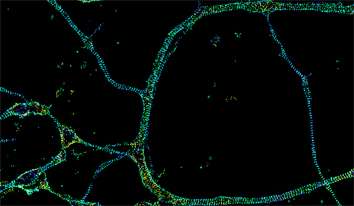Axons' unexpected cytoskeleton structure

(Phys.org)—The plasma membranes that give cells their shapes are typically upheld by linear meshworks of the protein actin. In contrast, Howard Hughes Medical Institute scientists have now discovered that periodic ring-shaped actin arrangements encircle the long axonal fibers of nerve cells.
The actin structures loop around axons at perfect intervals, which are connected by an associated cytoskeletal protein, spectrin. "No one has ever seen periodic rings like this formed by actin before," says HHMI investigator Xiaowei Zhuang, a biophysicist at Harvard University who led the study. The authors, who published their findings in the January 25, 2013, issue of the journal Science, suggest that these periodically distributed actin rings, connected by flexible spectrin tetramers, lend a flexible yet robust support for the skinny nerve fibers.
The cytoskeletal protein actin is found in all but the simplest cells. Its function is strongly influenced by the forms created by the organization of actin molecules. For example, a branched network of actin at the leading edge of motile cells helps them crawl and the actin-spectrin lattice of hexagons and pentagons in red blood cells helps the cells withstand compression as they circulate through vessels. Although experiments have shown that brain cells rely on actin for growth and stabilization of axons, among other things, the way in which actin is organized in the axon fibers has remained unknown.
Visualizing actin's form inside cells can help researchers better understand its function. However, individual actin filaments are so thin and so densely packed in cells that researchers have had difficulty distinguishing them using standard optical imaging techniques. But in 2006, Zhuang invented a method for imaging cells with resolution that far exceeds that achieved with conventional light microscopes. Last year, she and her colleagues directed this method at actin in the brain.
One of several methods of "super-resolution" imaging developed in the last decade, Zhuang's STORM (stochastic optical reconstruction microscopy) allows researchers to overcome limits imposed on convention light microscopy due to the diffraction of light. STORM works by turning on only a subset of fluorescent molecules in the sample at a time, and taking snapshots of these tiny glowing molecules at different times, so that their positions can be determined with very high precision. The coordinates of these fluorescent molecules are used to reconstruct an image of the sample. Zhuang describes it as a pointillistic approach.
Zhuang and her team decided to use the technique to examine fluorescently labeled actin within rat and mouse neurons. With STORM, the team was able to resolve structures as small as 10 nanometers (a ten-millionth of a millimeter) – about 20 times smaller than high-power confocal scanning microscopes can manage.
When Zhuang asked her team to image actin in neurons, their original target was the junctions where axons transmit messages to their neighboring cells – the synapses. However, post-doctoral researcher Ke Xu paused when he noticed regularly spaced fluorescent dots along the axons, instead of the expected continuous glowing lines. Xu and Guisheng Zhong, another postdoctoral research in the lab, investigated further and eventually revealed the novel cytoskeleton structure.
"When they first noticed the seemingly periodic pattern, it was not so obvious at all," says Zhuang. "These talented guys were so persistent in overcoming one difficulty after another to optimize the experimental conditions and eventually generate these beautiful and convincing images. I really love that they did not let go of this unexpected observation and simply go back to imaging synapses, as I asked them to."
Unveiling a new structure for actin proves STORM's worth, Zhuang says. "Making a scientific discovery is extremely rewarding for people like us who develop new methods. It is the ultimate validation of a method."
The dots turned out to be individual rings of actin encircling axons just below the cell membrane, along their length. Each actin ring consists of small actin filaments. The rings occur between spectrin spacers about 190 nanometers in length, which give the structure its periodicity. The team thinks that this ribbed structure might endow long axons with an ability to weave through the nervous system without snapping, as well as endure mechanical stress when an animal moves.
For comparison, the team also imaged actin within dendrites, neurons' branched projections. There, actin formed long filaments that ran along the dendritic shaft.
Next, the team discovered a sign that the periodic actin and spectrin rings might influence how nerve cells communicate with each other. Neurons communicate through action potentials, in which ion channels embedded in their membranes generate electrical charge that rises and falls quickly. The team found a periodic pattern among sodium ion channels in the axon membranes that corresponded to the underlying ringed lattice. "One can't help but wonder whether this periodicity influences the action potential," Zhuang says.
Just as the ultimate effect of ion channel periodicity remains mysterious, so too does the development of the actin and spectrin rings, and whether they indeed confer flexibility and durability as the team hypothesizes. "This is just the beginning." says Zhuang. "We discovered something so novel that we have opened up more questions than we answered."
More information: www.hhmi.org/research/investigators/zhuang.html
Journal information: Science
Provided by Howard Hughes Medical Institute

















